Wild Mint Sweater |
||||||||||||||||||||||||||||||||||
 |
 |
|||||||||||||||||||||||||||||||||
Knitted jumper in DROPS Cotton Merino. Piece is knitted top down with double neck, round yoke and texture pattern. Size: S - XXXL
DROPS 215-16 |
||||||||||||||||||||||||||||||||||
|
------------------------------------------------------- EXPLANATION FOR THE PATTERN: ------------------------------------------------------- PATTERN: See diagrams A.1 and A.2. Choose diagram for your size (applies to A.1). INCREASE TIP-1 (evenly): To calculate how to increase evenly, use the total number of stitches on row (e.g. 94 stitches) and divide stitches by number of increases to be done (e.g. 32) = 2.9. In this example increase by making 1 yarn over after approx. every 3rd stitch. On next round knit yarns over twisted to avoid holes. INCREASE TIP-2 (applies to sides of body): Increase 1 stitch on each side of A.2 in each side on body, i.e. increase as follows: Work until 1 stitch remains before A.2, make 1 yarn over, work 1 stitch in stocking stitch, work A.2 (= 9 stitches), work 1 stitch in stocking stitch, and make 1 yarn over (= 2 stitches increased in the side and 4 stitches increased in total on round.) On next round knit yarn overs twisted to avoid holes. Then work the new stitches in stocking stitch. DECREASE TIP (applies to mid under sleeves): Decrease 1 stitch on each side of A.2 mid under sleeve, i.e. work as follows: Work A.2 as before over the first 9 stitches, slip 1 stitch knitwise, knit 1, pass slipped stitch over stitch worked, work in stocking stitch until 2 stitches remain before A.2, knit 2 together (= 2 stitches decreased). CAST-OFF TIP: To avoid a tight cast-off edge you may use a larger needle size. If this also is too tight, work a 1 yarn over after approx. every 6th stitch while casting off (cast off yarn overs as regular stitches). ------------------------------------------------------- START THE PIECE HERE: ------------------------------------------------------- JUMPER - SHORT OVERVIEW OF THE PIECE: Double neck edge and yoke in the round on circular needle from mid back, top down. Now divide yoke for body and sleeves. Body is worked in the round on circular needle, top down. Work sleeves in the round on double pointed needles/short circular needle, top down. NECK EDGE: Cast on 94-98-102-108-112-116 stitches on a short circular needle size 3 mm with Cotton Merino. Work rib in the round = knit 1/purl 1 for 7 cm. Knit 1 round while increasing 32-32-34-36-38-38 stitches evenly - read INCREASE TIP-1 = 126-130-136-144-150-154 stitches. Insert 1 marker in the middle of round (= mid front). Measure yoke from this marker. Then work yoke as explained below. YOKE: Switch to circular needle size 4 mm and work in stocking stitch in the round. REMEMBER THE KNITTING TENSION! When piece measures 4 cm from marker in all sizes, increase 42-32-34-36-50-52 stitches evenly – remember INCREASE TIP-1 = 168-162-170-180-200-206 stitches. Continue until piece measures 4-5-6-7-7-8 cm - increase at the same time 0-18-10-18-31-39 stitches evenly on last round = 168-180-180-198-231-245 stitches. Now work A.1 in the round (= 28-30-30-33-33-35 repetitions of 6-6-6-6-7-7 stitches). When A.1 has been worked vertically, there are 280-300-330-363-396-420 stitches on row, and piece measures approx. 15-16-18-19-21-22 cm from marker at the neck. Continue in stocking stitch - increase at the same time 4-8-2-9-0-8 stitches evenly on first round = 284-308-332-372-396-428 stitches. When piece measures 19-21-23-25-27-29 cm from marker at the neck, divide yoke for body and sleeves. I.e. work next round as follows from mid back: Work 41-45-48-53-59-65 stitches in stocking stitch (= ½ back piece), slip the next 60-64-70-80-80-84 stitches on 1 stitch holder for sleeve, cast on 7-7-9-9-11-11 new stitches on needle (= in the side under sleeve), work 82-90-96-106-118-130 stitches in stocking stitch (= front piece), slip the next 60-64-70-80-80-84 stitches on 1 stitch holder for sleeve, cast on 7-7-9-9-11-11 new stitches on needle (= in the side under sleeve), and work the remaining 41-45-48-53-59-65 stitches in stocking stitch as before (= ½ back piece). Finish body and sleeves separately! NOW MEASURE PIECE FROM HERE! BODY: = 178-194-210-230-258-282 stitches. Insert 1 marker in each side on body - in the middle of the 7-7-9-9-11-11 stitches cast on under each sleeve. Work in stocking stitch over back piece until 4 stitches before first stitch with marker - round begin here now. Work A.2 (= 9 stitches – marker is in the middle of these 9 stitches), work 80-88-96-106-120-132 stitches in stocking stitch, work A.2 (= 9 stitches – marker is in the middle of these 9 stitches), work 80-88-96-106-120-132 stitches in stocking stitch. Continue pattern like this. When piece measures 6 cm from division in all sizes, increase 1 stitch on each side of A.2 in each side on body - read INCREASE TIP (= 4 stitches increased). Increase like this every 6 cm 3 times in total in each side = 190-206-222-242-270-294 stitches. Work until piece measures 25 cm from division. Approx. 3 cm remain until finished measurements, try the jumper on and work until desired length. On next round increase stitches evenly, i.e. work next round as follows: Work A.2 as before, work 86-94-102-112-126-138 stitches in stocking stitch and increase at the same time 19-21-23-25-27-29 stitches evenly over these stitches in stocking stitch, work A.2 as before, work 86-94-102-112-126-138 stitches in stocking stitch and increase at the same time 19-21-23-25-27-29 stitches evenly over these stitches in stocking stitch = 228-248-268-292-324-352 stitches. NOTE! Increase to avoid the rib to be worked from contracting the piece. Switch to circular needle size 3 mm. Work next round as follows: Work A.2 as before over the first 9 stitches, * knit 1, purl 1 *, work from *-* until 1 stitch remains before A.2 in the other side of piece, knit 1, work A.2 as before over the next 9 stitches, * knit 1, purl 1 *, work from *-* until 1 stitch remains on round, and finish with knit 1. Continue rib like this for 3 cm. Cast off with knit over knit and purl over purl - read CAST-OFF TIP. Jumper measures approx. 50-52-54-56-58-60 cm from shoulder and down. SLEEVES: Slip the 60-64-70-80-80-84 stitches from stitch holder in one side of piece on double pointed needles or a short circular needle size 4 mm and pick in addition up 1 stitch in each of the 7-7-9-9-11-11 new stitches cast on under sleeve = 67-71-79-89-91-95 stitches. Insert 1 marker in the middle of the 7-7-9-9-11-11 stitches. Begin round 4 stitches before stitch with marker, work A.2 (= 9 stitches – marker is in the middle of these 9 stitches), work the remaining stitches in stocking stitch. Continue pattern like this. When sleeve measures 3 cm from division in all sizes, decrease 1 stitch on each side of A.2 - read DECREASE TIP (= 2 stitches decreased). Decrease like this every 3½-3-2-1½-1½-1½ cm 10-11-14-18-18-18 times in total = 47-49-51-53-55-59 stitches. Work until sleeve measures 38-36-35-33-31-30 cm from division. Approx. 8 cm remain until finished measurements, try the jumper on and work until desired length. NOTE! Shorter measurements in the larger sizes because of wider neck and longer yoke. On next round increase stitches evenly, i.e. work next round as follows: Work A.2 as before, then work 38-40-42-44-46-50 stitches in stocking stitch and increase at the same time 9-9-11-11-11-11 stitches evenly over these stitches in stocking stitch = 56-58-62-64-66-70 stitches. Switch to double pointed needles size 3 mm. Work next round as follows: Work A.2 over the first 9 stitches, * knit 1, purl 1 *, work from *-* until 1 stitch remains before A.2 and finish with knit 1. Continue rib like this for 8 cm. Cast off with knit over knit and purl over purl - read CAST-OFF TIP. Sleeve measures approx. 46-44-43-41-39-38 cm from division. Work the other sleeve the same way. ASSEMBLY: Fold the neck edge towards wrong side, and fasten with neat, little stitches. |
||||||||||||||||||||||||||||||||||
Diagram explanations |
||||||||||||||||||||||||||||||||||
|
||||||||||||||||||||||||||||||||||

|
||||||||||||||||||||||||||||||||||
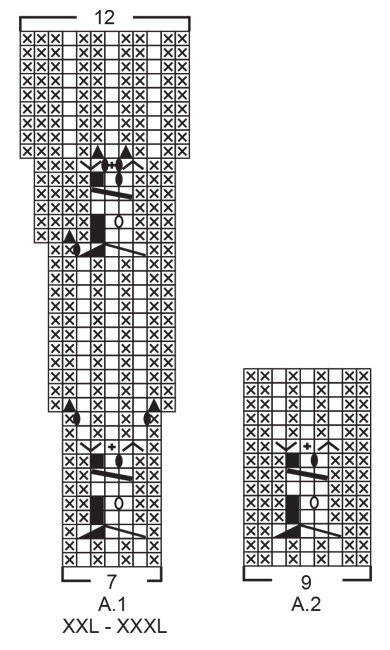
|
||||||||||||||||||||||||||||||||||
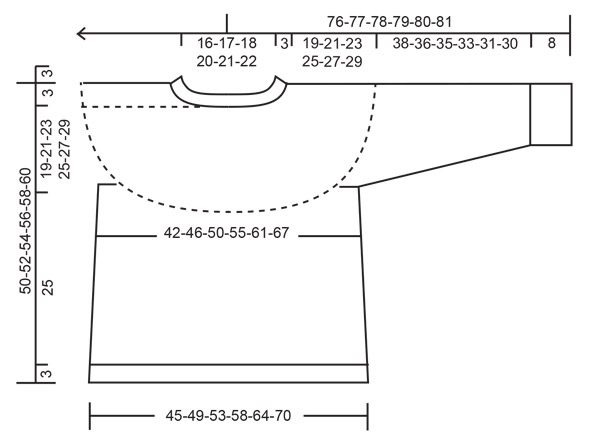
|
||||||||||||||||||||||||||||||||||
|
Have you made this or any other of our designs? Tag your pictures in social media with #dropsdesign so we can see them! Do you need help with this pattern?You'll find tutorial videos, a Comments/Questions area and more by visiting the pattern on garnstudio.com. © 1982-2024 DROPS Design A/S. We reserve all rights. This document, including all its sub-sections, has copyrights. Read more about what you can do with our patterns at the bottom of each pattern on our site. |
||||||||||||||||||||||||||||||||||







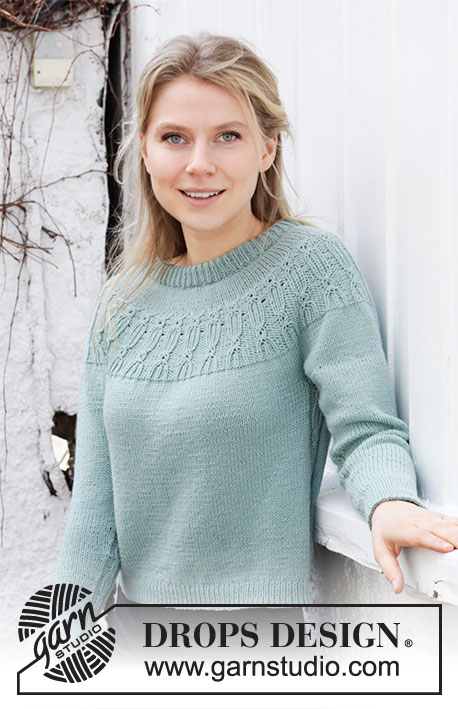

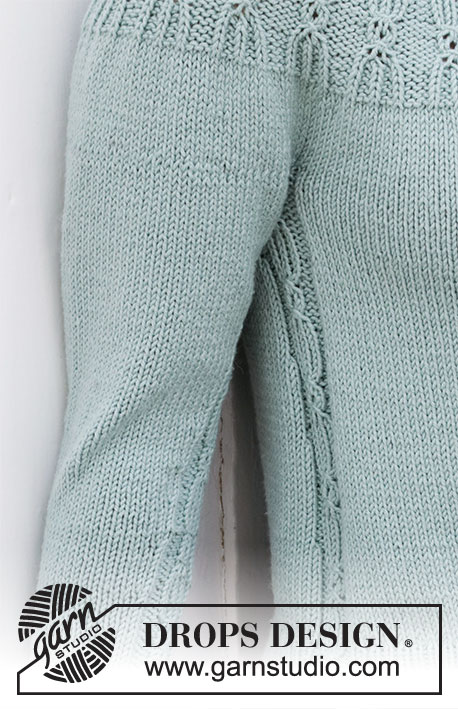

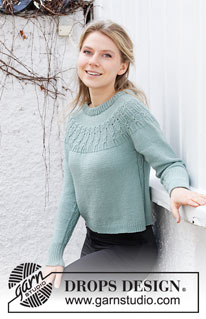
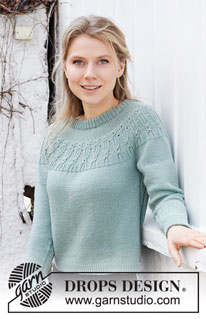
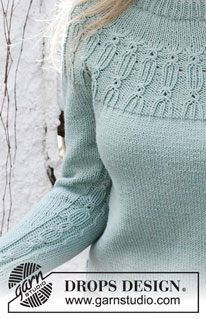
















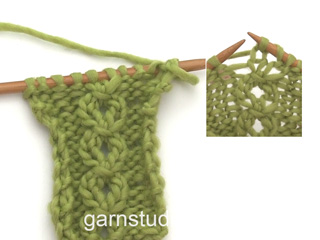


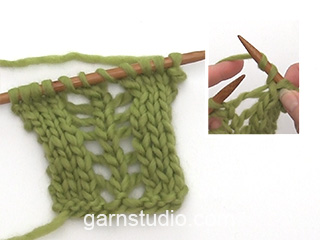






































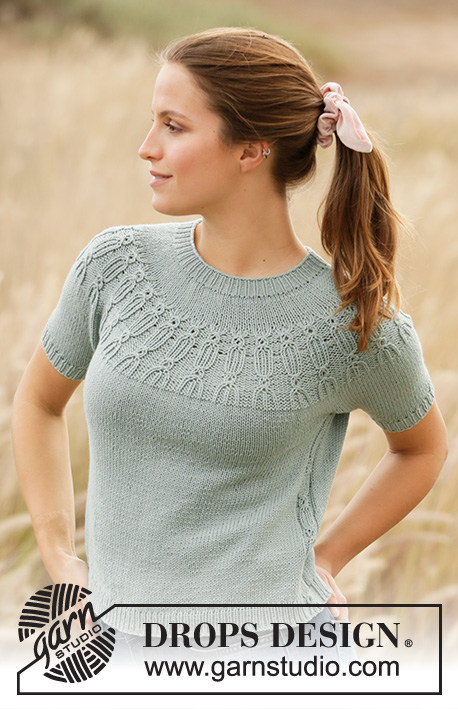






Comments / Questions (15)
A diagramhoz vonatkozó szöveges jelmagyarázatnál hiba van (az A1 sor 3.-ik sorában (is) szereplő fordított szemután levő jelnél). Kérem javítsák ki!
30.08.2023 - 21:43El patrón A2 de repite tantas veces como largo sea el jersey?
17.06.2023 - 20:54DROPS Design answered:
Hola Virginia, el diagrama A.2 se repite en el cuerpo del jersey y las mangas hasta el remate, incluyendo en el borde elástico final. Si quieres alargar el jersey, tendrías que continuar con las repeticiones de A.2 y los puntos del elástico (en el borde) o punto jersey (antes del borde) entre las repeticiones de A.2.
18.06.2023 - 20:08Ich habe eine Frage zu Musterreihe 22 von Diagramm A.1 (L-XL). Kann es sein, dass das 7. und 8. Symbol (von rechts gelesen) vertauscht sind? Denn so liegt das schwarze Dreieck (Umschlag links verschränkt stricken) nicht über der Stelle, an der sich der Umschlag der Vorreihe befindet, sondern über der linken Masche davor. Vielen Dank schon mal für die Hilfe!
01.06.2023 - 13:26DROPS Design answered:
Liebe Sabine, Sie sind ja recht, wie der Umschlag so ist, dann wird er bei der nächsten Runde zwischen den beiden linken Maschen gestrickt, danke für den Hinweis, unser Design-Team wird das mal prüfen. Viel Spaß beim stricken!
01.06.2023 - 16:37Det ved jeg godt. Der er en fejl i jeres beskrivelse
06.07.2022 - 08:08DROPS Design answered:
Hej Marianne, Vi skriver .... "slå om, strik 1 maske glatstrik, strik A.2 (= 9 masker), strik 1 maske glatstrik, og slå om (= 2 masker taget ud i siden "
06.07.2022 - 08:12Er der ikke en fejl i : UDTAGNINGSTIPS-2 (gælder i siderne på ryg- og forstykke) i forhold til jeres billeder? Der ser det ud som om der er taget ud efter sidste maske og ikke i den næst sidste maske? Her nu strikket hele kroppen og se det først nu. Så øv. Må så tage ind på ærmerne, så det passer, i næst sidste maske. Men for jo så ikke det mønster i opskriften.
05.07.2022 - 21:02DROPS Design answered:
Hej Marianne, du tager ud med 1 omslag på hver side af 1ret-A.2-1ret. God fornøjelse!
06.07.2022 - 08:04Are you sure about the 7 cm rib at the beginning? It looks a lot shorter in photographs.
17.12.2021 - 17:47DROPS Design answered:
Dear Chiara, yes, it is 7 cm because as the pattern states at the very wnd, that ribbing at the neck should be folded over and sewn down. Happy Knitting!
18.12.2021 - 04:36Een over drop 215-16. Bij de derde regel bij het onderwerp Lijf : De regel brei in tricotsteek tot er 4 steken voor de eerste steek met de markeerdraad zijn. Mijn vraag is de markeerdraad van middenachter of ?????? Groetjes.Laurien.
02.08.2021 - 15:50DROPS Design answered:
Dag Laurien,
Nee, dit betreft de markeerdraad die je vlak daarvoor hebt ingevoegd in de zijkant van het werk. Dit is nu het begin van de naald.
18.08.2021 - 19:46Heb een vraag:Ik snap het niet . Het gaat over \"Drops Design 215-16\": dat stukje van het lijf de 3e regel over tot er 4 steken.markeerdraad - de naald begint hier.\r\n\r\nEn daarna moet ik a2 breien.\r\n\r\nBedankt.Laurien.
26.07.2021 - 17:06DROPS Design answered:
Dag Laurien,
Ja, dat klopt. Je breit eerst tot 4 steken voor de eerste steek met de markeerdraad. Dan begin je inderdaad met A.2 zoals aangegeven in de beschrijving.
19.08.2021 - 14:06Do you use two cable needles (small needles) for A.1 row 3? Many thanks!
20.05.2021 - 13:49DROPS Design answered:
Dear Jian, just one is enough, when working the 7th symbol from diagram key, use first the cable needle there: slip 1 stitch on cable needle in front of piece, purl 1, knit 1 from cable needle => there is no stitch anymore on the cable needle, then knit 1, and use cable needle one more time: slip 1 stitch on a cable needle behind piece, knit 1, lift the innermost of the 3 knit stitches at the edge of right needle over the 2 outermost knit stitches so that stitch is around the other two (= 1 stitch decreased), purl 1 from cable needle => there is no stitch anymore on the cable needle. Hope this will help. Happy knitting!
20.05.2021 - 16:00My question is about row 3 in diagram A-1 L-LX. I am having a problem with the part that starts with: lift the innermost of the 3 knit sts at the edge of the right hand needle etc.. Do I pass the 3 sts off the rt needle onto the lefthand needle. add the 2 outermost sts onto the lefthand needle and pass the 3 sts over the 2 sts and then back onto the rt needle?
21.12.2020 - 11:18DROPS Design answered:
Dear Mrs Flaherty, count 3 sts from the tip of right needle (= from the tip you have 2 sts from the small cable over 2 sts and the knit stitch from the first small cable, this knit stitch is the one you will pas over the last 2 knitted stitch. Happy knitting!
21.12.2020 - 14:14